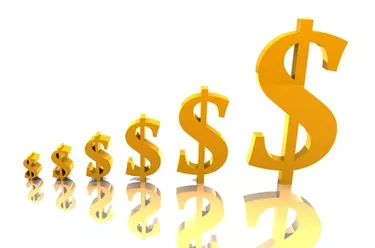
Certificates of deposit (CDs) present simple and compound interest. Compound interest is more profitable to the lender if the CD term is longer than the compounding period. We see the systematic "mechanics" of compounding, as well as advantage of shorter compounding period. In calculating interest gains, precision is necessary. Exponents can amplify tiny numeric differences to the point of disagreement about how much is owed.
Simple Interest
Video of the Day
Non-compound, or simple interest, calculates percent based on the initial deposit. If a CD has 5 percent simple interest rate (r = 0.05) and the CD term is ten years (t = 10), then initial deposit (principal, “P”) would give final gain (F) by the formula F = P_r_t. if P = 1000, r = 0.05, t = 10; then F = 1000_0.05_10 = 500. At the end of the CD, the lender gains $500. Total amount received is 1,000 + 500 = $1,500.
Video of the Day
Compound Interest
All else being equal, compound interest pays off more than simple interest. Let r = 0.05 and initial amount invested be $1,000. Same ten-year CD term. As before, P = 1000, r = 0.05, t = 10. General formula for final receive amount is a bit more complex: F = P_[(1 + r)^t]. Substituting the given values, the equation becomes F = 1000_(1.05^10) = 1000*1.6289 = $1,628.89. Note that with compound interest, the gain over ten years was $628.89 instead of $500. The reason being is that the rate acts on prior interest gained.
Compounding Mechanics
In the first year, there is no difference. 1000_.05 = 50, so $50 gained. However, in the second year, the 5 percent rate acts on the $1050, not on initial $1,000 deposit. After two years, gain is: 1050_.05 = 52.5, so total amount after two years is 1050 + 52.5 = $1,102.50. With simple interest, the CD would have only $1,100 at this point. Similarly, after three years, the interest rate acts on 1,102.50, giving: 1102.50*.05 = 55.125. 1102.50 + 55.125 = 1,157.625, or $1,157.63 in the account. Simple interest would give $1,150.00. The compounding advantage magnifies with time.
Compounding Time Periods
We know that with an annual rate of 5 percent, $1,000 becomes $1,050.00. If the money was compounded monthly, the rate would be divided by 12 (5/12 = 0.004167), and the time “t=1” would be expressed as t/12, or 1/12. The new formula for compounding would be F = P_(1 + r/12)^(t/12). Therefore F = 1000_(1.004167^[1/12]). F = 1000*(1.00034) = 1000.3465. Rounded off to the nearest cent, quarterly compounding gives $1,000.35. A small difference, but once again, compounded over years and even decades, it can become substantial.
Precision in Calculations
In the above calculations, decimals were carried five or six digits past the decimal point. Even though “real money” is accurate to a cent, exponents can magnify even a small difference. In order to maintain accuracy and clear communication about how much a lender expects to receive—especially with compound interest--calculations have to be done with far more decimal places than the two required for accuracy-to-the-penny payouts.